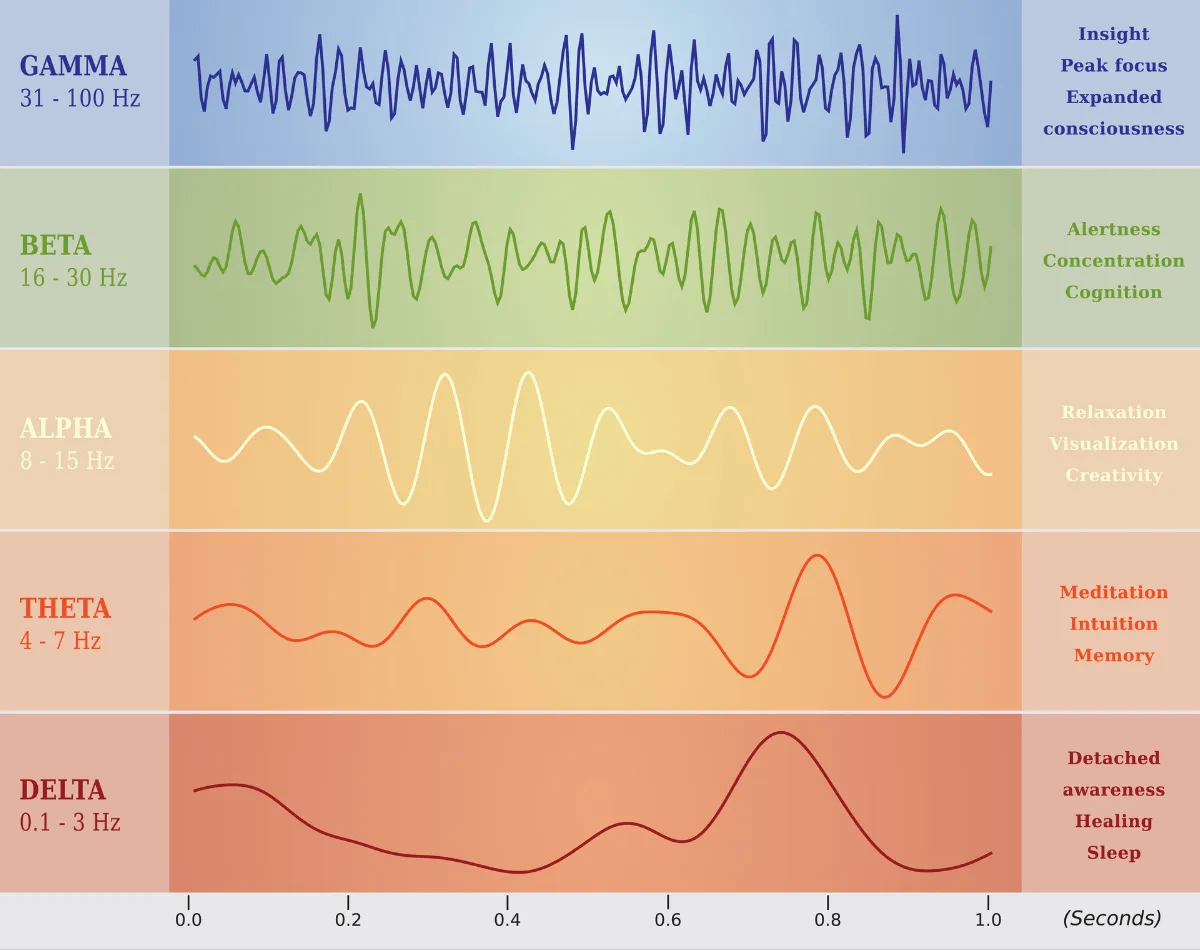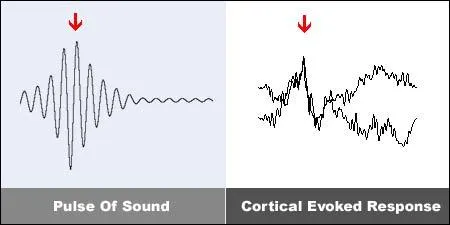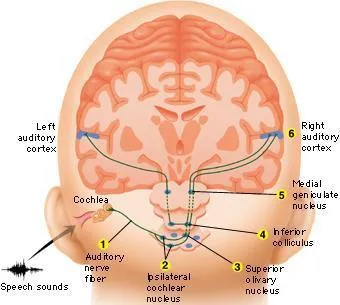Understanding Brainwaves

‘Brainwaves’ are produced as the billions of neurons in our brains transmit action potentials, explosions of electrical activity sometimes called "spikes" or "pulses," down their axons to the synapses where they trigger the release of neurotransmitters. These action potentials are essentially electrical charges that are passed from neuron to neuron.
By placing sensors on the scalp through the use of electroencephalograph technology (an EEG machine), researchers can detect not the individual firings of neurons—they are far too small and numerous to differentiate—but the sum total of this electrical activity, dubbed ‘brainwaves’ for their cyclical nature as shown in the diagram above.
One of the problems with modern society is that we tend to ‘drive’ our minds in such a way that our brainwaves remain in the Beta level seen in the diagram above. We live in a continually stressed out state of what we refer to as “Beta frazzle.” Most people tend to rush around, think too much, multi-task and frequently overload their minds with stressful thoughts. At the other end of the spectrum, some people hardly use their minds or challenge themselves at all. Unfortunately, most people have very little natural control over their dominant brainwave state and hence can’t easily access the significant benefits provided by the other brainwave levels seen in the diagram above (Gamma, Alpha, Theta or Delta.)
Properly engineered brainwave technology, however, can influence your brainwaves by providing an audio stimulus that, so long as the necessary conditions are met, can guide your dominant brainwave state to the desired frequency. This is significant, because the combination of the right audio technology and a set of headphones can provide an access point to positively influence your cognitive function and achieve beneficial states such as deep relaxation, enhanced memory and mental performance or increased energy, focus and motivation.
Through over 40 years of research, we have developed specialized pulsed tones that are unparalleled in their ability to stimulate and entrain your brain in this way.
What is Brainwave
Entrainment (BWE)?
Brainwave entrainment is about the synchronizing of
brainwaves in order to put the brain in a specific state
(Alpha, Beta, Delta, Gamma or Theta,) which can result in
a wide range of benefits, from reduced anxiety and better
sleep, to faster reflexes and better focus/concentration.
Instead of the standard binaural beats that most people
associate with brain entrainment, we use a proprietary
system based on isochronic and monaural stimulation
patterns, which is more efficient and helps to achieve
peak performance (emotionally, mentally and physically)
in a much shorter period of time.
One of the great things about BWE is that it can be used
on its own, or with many other modalities, to intensify the
effects of whatever you choose to use with it.
Morry Zelcovitch, Brainwave Entrainment Engineer for MindTrainer PRO

What Happens in the
Brain When We Listen
When the brain receives an audio stimulus through the ears and auditory pathways, it emits an electrical charge in response, called the Cortical Evoked Response
. These electrical responses are then processed throughout the brain to become what you hear. When rhythms that resemble natural internal brainwave states are presented to the brain, the brain will synchronize its own electric cycles producing comparable states of mind – such as deep relaxation or heightened wakefulness. This tendency of the brain to tune in to and match to the external stimulus’ frequency is a phenomenon known in scientific terms as the Frequency Following Response (“FFR”).
It is worth noting here that your brain will never get used to our audio entrainment recordings. It will continue to respond to them as a result of this FFR. The FFR does not go away with use or time and is not affected by how many times it’s activated – it is always there.
How MindTrainer PRO Works at a
Neurological Level
In order for effective entrainment to occur, a constant, repetitive stimulus of sufficient strength to ‘excite’ the thalamus must be present (the thalamus is our sensory relay center within our midbrain). The thalamus (specifically, the medial geniculate nucleus within the thalamus as seen in the diagram below) then passes the stimuli onto the sensory-motor strip, the neo-cortex in general and associated processing areas such as the auditory cortices in the temporal lobes and the pre-frontal cortex. Through listening to our unique technology, the brain is pushed to create new neural pathways, changing patterns of perception and information transfer, thereby creating new ways of experiencing your surroundings and dealing with stress. It is at this stage when the benefits of properly engineered brainwave entrainment have a genuine effect.

This diagram shows the neural pathways of hearing. Sound passes through the ear into the cochlea where the auditory nerves are located. The signals from these nerves are carried down to several locations. One is called the superior olive. In the superior olive, the minute differences in the timing and loudness of the sound in each ear are compared, and from this you can determine the direction the sound came from. Another point is the medial geniculate of the thalamus (a relay point) from where auditory information is then transmitted to the main cortex and the auditory cortex simultaneously. Entrainment only occurs from the thalamic relay point (from the medial geniculate nucleus) and not through the olivary bodies where traditional forms of brainwave entrainment technology such as ‘Binaural Beats’ are heard. By definition, entrainment occurs when the brain wave frequency duplicates that of the stimuli, whether audio, visual or tactile (Siever, 2003) as can be seen on an EEG.
It’s critical that the brainwave entrainment technology you listen to must meet both the physiological criteria (the actual cortical evoked response) and the psychological criteria (a person’s mental acceptance of the tones) to be effective. This combination is where MindTrainer PRO's specialty lies and why our products have such a positive effect on our listeners.
Independent TMM System
Research Study
The Role of the TMM System in the Improvement of Training
Performance on 1st Year Students from the Military Police of
Magrosso State
The Brazilian government contacted Morry Zelcovitch, creator of The Morry Method™ (TMM) technology, now known as the Quantum Mind Method
(QMM), to possibly help with such things as posttraumatic stress disorder,
work related efficiency, and many other factors and facets of everyday life
in the Brazilian armed forces and military police.
On October 8, 2009, the findings of an 84-page research study, which
involved the use of The Morry Method™ recordings exclusively in a major
university research project in Brazil, were released. The findings of this
study concluded that TMM technology not only helped Officers’ fulfill their
daily duties in a more efficient, effective and healthful manner, but also
helped with major stress indicators in the performance of otherwise very
stressful and even dangerous duties.
An Experimental Intervention for
Reducing Math Anxiety and
Fostering Positive Social
Change
by Dr. Glenroy Pinnock
More than 30% of university students with math anxiety taking introductory math failed precalculus in Jamaica. Research has found that lowering math anxiety can lead to better math performance, and the use of isochronic tones has been linked to anxiety reduction.
The purpose of this pre and posttest wait-control experiment conducted at a small urban university in Jamaica was to explore the relationship between exposure to isochronic tones and math anxiety.
Two groups (n = 21 treatment; n = 27 control) of university introductory precalculus math students displaying differing levels of math anxiety were treated in 18 10-minute sessions with isochronic tones and measured on both math anxiety (Math Anxiety Rating Scales-Short) and math performance (standard mathematics exam).
Students’ pre and posttest math and math anxiety scores were examined. The correlation between the math pretest and the math anxiety pretest was found to be statistically significant. In addition, the mean math posttest score differences between Groups 1 and 2 were statistically significant, favoring the treatment group.
Last, for posttest math anxiety, the mean differences between Groups 1 and 2 were statistically significant, favoring the treatment group with lower math anxiety. The project and recommendations involved examining other ways of reducing math anxiety in addition to isochronic tones and suggestions for the examination of other interventions to improve students’ mathematical outcomes in education. The implications for positive social change include informing local teachers, parents, policy makers, and students about the problem of math anxiety and possible treatments to reduce it. As a result, it is hoped that students’ math anxiety will be reduced and greater math achievement realized.
Additional Research and
Resources
References on MindTrainer PRO Brainwaves
Entrainment Technology
The following are references and studies that we credit in part for our audio entrainment technology. We also must acknowledge the work and research of David Siever, who we regard as the true pioneer of the brainwave entrainment field:
Adrian, E. D. & Yamagiwa, K., “The Origin of the Berger Rhythm.” Brain, 58, 323-351, 1935.
Atwater, F. H., “The Monroe Institute’s Hemisync Process: A Theoretical Perspective.” Faber, Va, Monroe Institute, 1988.
Barabasz, A. & Barabasz, M. (1995). Attention deficit Hyperactivity disorder: Neurological basis and training Alternatives. Journal of Neurotherapy, Summer 1995.
Berg, K., & Siever, D. (2004). The effect of audio-visual entrainment in depressed community-dwelling
senior citizens who fall. In-house manuscript. Mind Alive Inc., Edmonton, Alberta, Canada.
Berg, K. & Siever, D. (2009). A Controlled Comparison of Audio-visual Entrainment for Treating SAD.
Journal of Neurotherapy, Vol 13, 3, 166-175.
Blakemore, C. and Greenfield, S. (Ed.) Mindwaves: Thoughts on Intelligence, Identity and Consciousness. Blackwell, Oxford, 1987.
Budzynski, T. H., “Brain Lateralization and BiofeedBack.”In B. Shapin & T. Coly, Brain/Mind and Parapsychology. New York: Parapsychology Foundation, 1979.
Bruneau, N., Sylvie, R., Guerin, P., Garreau, B., & Lelord, G. (1993). Auditory stimulus intensity
Responses and frontal midline theta rhythm. Electroencephalography and Clinical Neurophysiology,
186, 213-316.
Donker, 0. N.J., Nijo, L., Storm Van Leeuwen, W. & Wienke, G., “Inter-hemispheric Relationships of
Responses to Sine Wave Modulated Light in Normal Subjects and Patients.”
Cade, C. M. & Coxhead, N., “The Awakened Mind: BiofeedBack and the Development of Higher States of
Consciousness.” New York: Delacorte Press, 1979
Dumas, R. A. (1977). EEG alpha-hypnotizability Correlations: A review. Psychophysiology, 14, 431438.
Empson, J. (1986). Human brainwaves: The psychological Significance of the electroencephalogram. London: The Macmillan Press Ltd.
Electroencephalography and Clinical Neurophysiology, 44, 479-489, 1978.
Foster, D.S., “EEG and Subjective Correlates of Alpha Frequency Binaural Beats Stimulation Combined With Alpha BiofeedBack.” Ann Arbor, Ml: UMI, Order No.9025506, 1990.
Foulkes, D. & Vogel, G. (1964). “Mental Activity At Sleep Onset.” Journal of Abnormal Psychology, 70, 231-243, 1964.
Glicksohn, J., “Photic Driving and Altered States of Consciousness: An Exploratory Study.” Imagination,
Cognition and Personality, 6,167-182, 1986.
Green, E. E., & Green, A. M., “Biofeedback and States Of Consciousness.” In B. B. Wolman & M. UlIman.
Handbook of States of Consciousness. New York: Van Nostrand Reinhold, 1986.
Harding, G. F. & Dimitrakoudi, M. “The Visual Evoked Potential in Photosensitive Epilepsy.” In J. E.
Desmedt, Visual Evoked Potentials in Man: New Developments. Oxford: Clarendon, 1977.
Hoovey, Z., Heinemann, U. & Creutzfeldt, O., “Inter-hemispheric ‘Synchrony’ of Alpha Waves.”
Electroencephalography and Clinical Neurophysiology, 32, 337-347, 1972.
Ishihara, T., & Yoshii, N. (1972). Multivariate Analytic study of EEG and mental activity in juvenile
Delinquents. Electroencephalography and Clinical Neurophysiology, 33, 71-80.
Joyce, M., & Siever, D. (2000). Audio-visual entrainment program as a treatment for behavior disorders
in a school setting. Journal of Neurotherapy. 4, (2) 9-15.
Kooi, K. A., Fundamentals of Electroencephalography. New York: Harper & Row, 1971.
Kubie, L., “The Use of Induced Hypnagogic Reveries in the Recovery of Repressed Amnesic Data.” Bull. Menninger Cilnic, 7,172-182, 1943.
Lilly, J. C., Programming and Meta Programming in the Human Bio-computer. New York: Julian, 1972.
Lynch, G., and Baudry, M. The Biochemistry of Memory: a New and Specific Hypothesis, Science, 224:1057-63,1984.
Lubar, J. F., “Electroencephalographic Biofeedback and Neurological Applications.” In J. V. Basmajian,
BiofeedBack: Principles and Practice, New York: Williams & Wilkins, 1989.
Lubar, J. F. (1991). Discourse on the development of EEG diagnostics and biofeedback for Attention-deficit/hyperactivity disorders. Biofeedback And Self-Regulation, 10(8), 201-225.
Lubar, J. F., Swartwood, M. O., Swartwood, J. N., & O’Donnell, P. H. (1995). Evaluation of the effectiveness of EEG neuro feedback training for ADHD in A clinical setting as measured by changes in T.O.V.A. Scores, behavioral ratings, and WISC-R performance. Biofeedback and Self Regulation, 20(l), 83-99.
Mizuki, Y., Tanaka, M., lsozaki, H., & Inanaga, K. (1980). Periodic appearance of theta rhythm in the
Frontal midline area during performance of a mental Task. Electroencephalography and Clinical
Neurophysiology, 49, 345-351.
Oster, G., “Auditory Beats in the Brain.” Scientific American, 229, 94-102, 1973.
Peniston, E.G. & Kulkowski, P. J., “Alpha-Theta Brainwave Training and Beta Endorphin Levels in Alcoholics.” Alcoholism, 13, 271-279, 1989.
Peniston, E. G. (1990). EEG brainwave training as a Bio-behavior intervention for Vietnam combat-related PTSD. The Medical Psychotherapist, 6(2).
Peniston, E. G. & Kulkosky (1991). Alpha-theta Brainwave neuro feedback for Vietnam veterans with
Combat related post-traumatic stress disorder. Medical Psychoth
erapy: An International Journal, 4, 1-14.
Richardson, A. & McAndres, F., “The Effects of Photic Stimulation and Private Self-consciousness on the
Complexity of Visual Imagination Imagery.” British Journal of Psychology, 81,381-394, 1990.
Rosenfield, Isreal, Neural Darwinism: A New Approach to Memory and Perception, The New York Review of Books, 9 October 1986.
Saxby, E. & Peniston, E. G. (1995). Alpha-theta Brainwave neuro feedback training: An effective training
For male and female alcoholics with depressive Symptoms. Journal of Clinical Psychology, 51(5), 685-693.
Schacter, D. L., “EEG Theta Waves and Psychological Phenomena: A Review and Analysis.” Psychology, 5, 47-82, 1977.
Sittenfeld, P., Budzynski, T. & Stoyva, J., “Differential Shaping of EEG Theta Rhythms.” BiofeedBack and Self-Regulation, 1, 31-45, 1976.
© 2023 Copyrights by MindTrainer Pro. All Rights Reserved.

